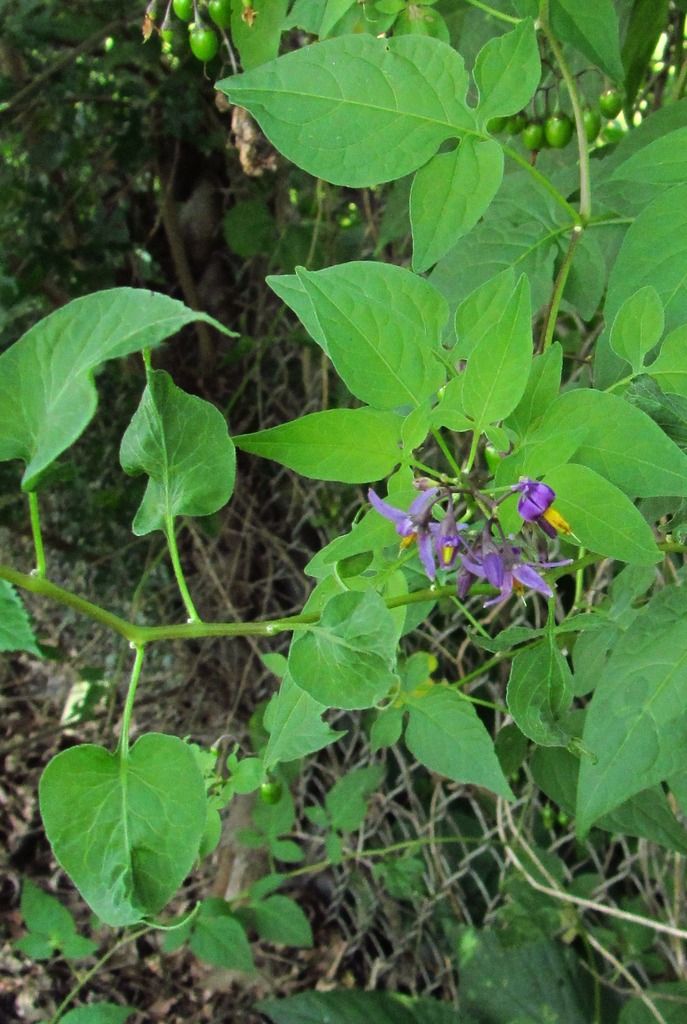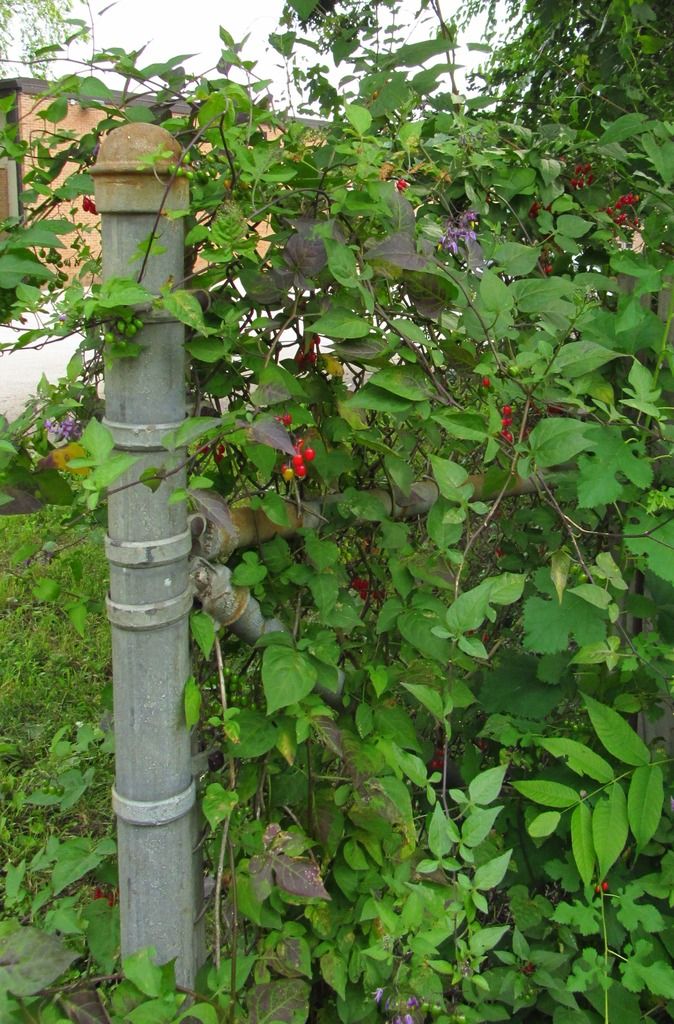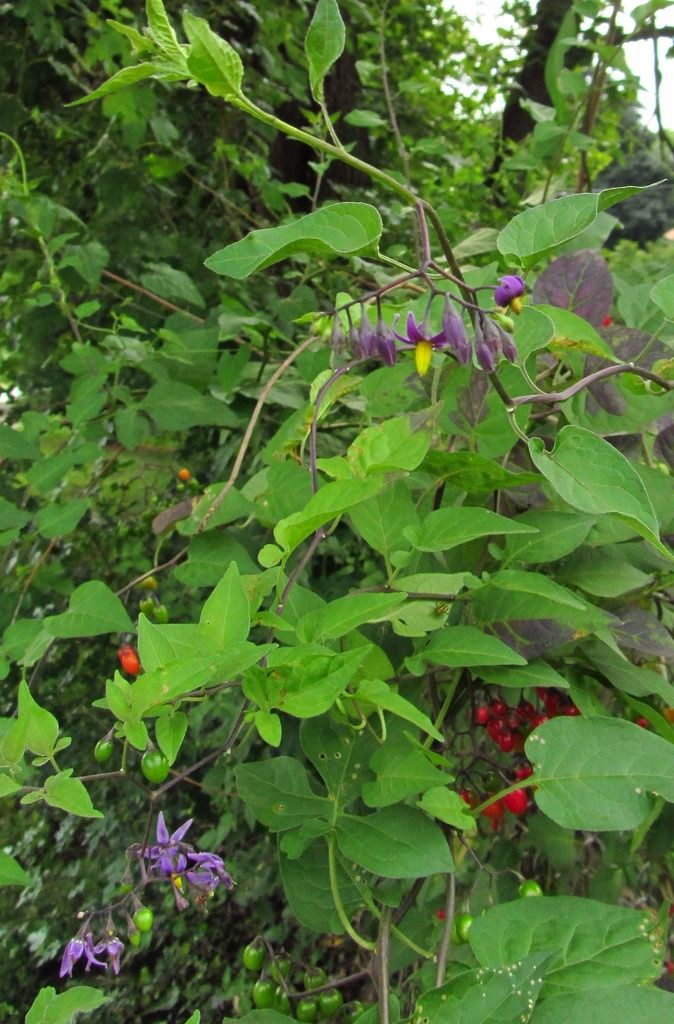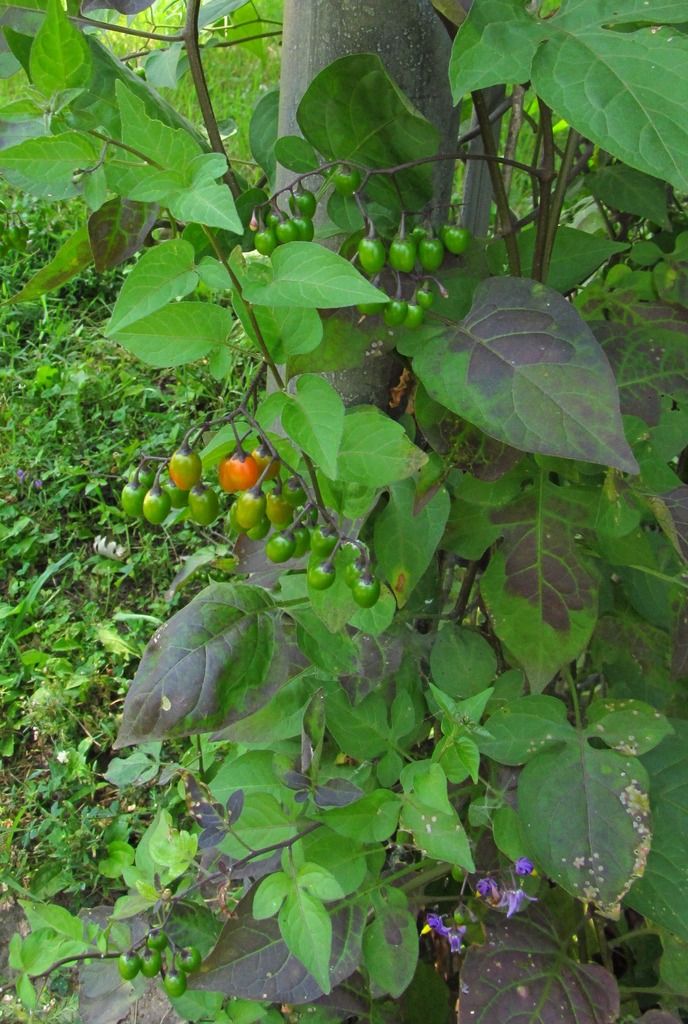I’m bending the rules again by featuring a European native rather than a plant endemic to Iowa. Bittersweet nightshade (Solanum dulcamara) can be found in most of the United States and Canada, especially “in the eastern and north-central United States, […] the upper Great Lakes states […] and the Pacific Northwest.” This “semi-woody vine” is sometimes known as climbing nightshade, wood nightshade, or European bittersweet. Like dayflower, it has become widespread in Iowa and many other states. Some people call such plants “nativized.”
Bittersweet nightshade is not on Iowa’s noxious weed list, unlike fellow European invader poison hemlock or Carolina horse nettle, a native North American plant. I’ve mostly seen this vine growing on fences at the edges of yards, rather than in unspoiled habitat. I took all of the enclosed pictures right here in Windsor Heights. Canadian photographer Brian Johnston has taken phenomenal close-up shots of Bittersweet nightshade flowers. Click through; you won’t be disappointed.
This post is also a mid-week open thread: all topics welcome.
For a detailed botanical description of Solanum dulcamara, see this page on the U.S. Forest Service’s website or the Illinois Wildflowers page. The King County, Washington website provides tips on identifying this plant that are easier to understand:
• Perennial vine or sprawling shrub; lower stems woody, upper herbaceous branches die back each year
• Flowers have star-shaped, purple, backward-pointing petals and stamens fused in a prominent yellow cone; grow in clusters along branches on short stalks extending out from the stems
• Berries are round or egg-shaped and bright red when ripe with numerous yellow, flattened seeds; unripe berries are green
• Leaves are dark-green to purplish and often with one or two small ear-like lobes near the base, leaf blades are 1 to 4 inches long
• Main root grows horizontally just below the surface and suckers frequently
• Crushed leaves and bark have an unpleasant smell
There are two easy ways to distinguish Bittersweet nightshade from Black nightshade (Solanum nigrum) or American nightshade (Solanum americanum). First, Bittersweet nightshade has purple flowers, unlike the white flowers of Black nightshade. A closer view of the flowers:
Second, Bittersweet nightshade berries turn bright red when ripe. Black nightshade berries turn black (or very dark purple). Experts debate whether it’s prudent to eat ripe Black nightshade berries. The King County website notes of Bittersweet nightshade,
Although this is not the same plant as deadly nightshade or belladonna (an uncommon and extremely poisonous plant), bittersweet nightshade is somewhat poisonous and has caused loss of livestock and pet poisoning and, more rarely, sickness and even death in children who have eaten the berries. Fortunately, bittersweet nightshade has a strong, unpleasant odor, so most animals will avoid it, and poisonings from this plant are not very frequent.
The entire plant contains solanine, the same toxin found in green potatoes and other members of the nightshade family, and it also contains a glycoside called dulcamarine, similar in structure and effects to atropine, one of the toxins found in deadly nightshade. The toxin amount varies with soil, light, climate and growth stage. Ripe fruits are generally less toxic than the leaves and unripe berries, but even ripe berries can be poisonous.
I wouldn’t chance tasting any part of this plant. The Illinois Wildflowers website cautions people who are trying to eradicate the plant,
Bittersweet Nightshade prefers full or partial sun, and moist to mesic soil that is loamy and fertile. However, because of its robust nature, this plant can adapt to drier conditions and other kinds of soil. It can spread aggressively and be difficult to get rid of because small pieces of rhizome in the soil can regenerate new plants. It is wise to wear gloves while attempting to remove this plant by hand as the foliage is toxic.
Bittersweet nightshade vines start out small:
They can grow quite tall and thick under favorable conditions. Here Bittersweet nightshade is thriving along a chain-link fence. That’s my alma mater, Clive Elementary School, in the background. (Every four years the building doubles as the precinct caucus location for Windsor Heights 2.)
Bittersweet nightshades can bloom over a long period in the summer. You may see clusters of purple flowers, green berries, and ripe berries on the same vine.
Here are some unripe berries:
Berries ripening:







1 Comment
Interesting...
I haven’t heard the term “nativized” before. The term I’ve heard is “naturalized,” and that term bothers me because it is used sometimes to imply that if an invasive alien spreads around in natural areas enough, it somehow becomes “natural.” Not so. Bittersweet nightshade is on the low end of the problem scale in Iowa, but there is no guarantee that will always be true, especially with more climate change ahead.
PrairieFan Mon 24 Apr 1:29 PM